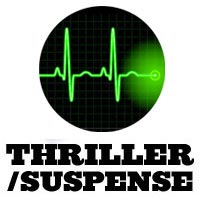Espionage/Spy Film Thrillers:
A sub-genre of the thriller/suspense film is the espionage/spy film
which can be in the form of a drama, melodrama, comedy, or a good-humored
action thriller, set either during wartime or in the Cold War Era.
The spy film was most popular during the 1960s when the Cold War
was in evidence, and audiences demanded more action/thriller-suspense
pictures. [Spies and espionage plots have also been the basis for
many TV shows, such as The
Man from U.N.C.L.E, I Spy, Alias, and the UK's The
Avengers.]
Espionage films could either be serious, fact-based
stories (i.e., The Spy Who Came In From the Cold (1965) or
films based upon novelists' fictional or fact-based works), or fanciful-escapist
films (such as the James Bond series). Spies in real-world
situations are often murky, unknown characters who don't want to
be revealed, but are truly unknown, non-flashy undercover agents.
In any case, most spy films usually depicted spies and/or secret
agents seeking to uncover or maintain secrets (often for military
use) from each other (or from each other's countries). Spies were
usually portrayed as masquerading, amoral, and deceitful characters
ready to betray others.
Hitchcock's Spy-Related Films:
As already noted, many of Alfred Hitchcock's suspense/thriller
films, especially during his early years, were espionage/spy subgenre
films, and he was responsible for the popularity of this kind of
film. Most notable were:
- The Man Who Knew Too Much (1934)
- The 39 Steps (1935)
- Secret Agent (1936)
- Sabotage (1936)
- The Lady Vanishes (1938)
- Foreign Correspondent (1940)
- Saboteur (1942)
- Notorious (1946), with playgirl Ingrid Bergman who 'prostituted'
herself by marrying Rio de Janeiro neo-Nazi Claude Rains in order to obtain
secrets about uranium (the MacGuffin) in his wine cellar, while engaged
in a love triangle with icy Cary Grant as American secret agent Devlin
- North By Northwest (1959), a 'wrong man' story in which Cary
Grant was mistaken for non-existent secret agent George Kaplan, and faced
villainous James Mason
'Pre-James Bond' Spy Films with Memorable Spy Agents:
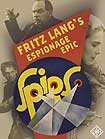 Fritz
Lang's Spies (1928), the director's first independent production,
with an anarchist international conspirator and criminal spy character named
Haghi (Rudolf Klein-Rogge), who was pursued by good-guy Agent No. 326 (Willy
Fritsch) (aka Det. Donald Tremaine, English version) - this film anticipated
the James Bond films of the future Fritz
Lang's Spies (1928), the director's first independent production,
with an anarchist international conspirator and criminal spy character named
Haghi (Rudolf Klein-Rogge), who was pursued by good-guy Agent No. 326 (Willy
Fritsch) (aka Det. Donald Tremaine, English version) - this film anticipated
the James Bond films of the future- Greta Garbo's portrayal of the real-life, notorious, seductive
German double-agent code-named Mata Hari (Gertrud Zelle) in WWI in Mata
Hari (1932), who performed a pearl-draped dance to entice French officers
to divulge their secrets, but in real-life was shot by a French firing squad
in 1917 for espionage; other actresses who starred as the WWI undercover
agent include Asta Nielsen in Mata Hari (1920), Magda Sonja in Mata
Hari (1927, Ger.), Marlene Dietrich as Agent X-27 in Dishonored (1931),
Jeanne Moreau in Mata Hari Agent H 21 (1965, Fr.), Zsa Zsa Gabor
in the comedy Up the Front (1972), Sylvia Kristel in the R-rated Mata Hari (1985), and Maruschka Detmers in Mata Hari, la vraie
histoire (2003, TV)
- Confessions of a Nazi Spy (1939)
- The House on 92nd Street (1945)
- Fritz Lang's atmospheric post-war spy melodrama Cloak
and Dagger (1946), with Gary Cooper starring as
atomic scientist and physics professor Alvah Jasper (a character based upon
A-bomb co-developer J. Robert Oppenheimer), on a mission to discover Germany's
secret plans to build an A bomb
- Henry Hathaway's 13 Rue Madeleine (1947), a documentary-style
wartime espionage tale with James Cagney (as Bob Sharkey), an O.S.S. (Office
of Strategic Services) agent sent into occupied France to uncover the site
of a German missile silo before the Allied landing at Normandy on D-Day
- Henry Hathaway's Diplomatic Courier (1952), with
Tyrone Power as an undercover secret agent in search of documents with details
of the Russian invasion of Yugoslavia
- James Mason as undercover agent Ulysses Diello (code-named
Cicero), working in the British embassy in Turkey during WWII, and selling
secrets to the Nazis, in Joseph Mankiewicz's Five Fingers (1952),
based upon the novel Operation Cicero by real-life "Cicero"
L.C. Moyzisch (based on a true story)
James Bond Espionage-Secret Agent Thrillers:
(See Greatest
Series Franchises of All-Time: James Bond films for more
details on all of the Bond films.)
The modern day action-hero - the James Bond '007' character
that was employed for Her Majesty's Secret Service - was loosely
based on the agent/spy character in Britisher Ian Fleming's twelve
James Bond novels. A number of Fleming's short stories were developed
by other writers. Before the movies, Bond made his first appearance
on TV, debuting on CBS in 1954, with Barry Nelson as the American
007 agent named Jimmy Bond in an adaptation of Fleming's first Bond
novel, Casino Royale.
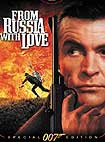 The
first in a successful series of suspenseful, special agent 007 James
Bond films, begun in the Cold-War 1960s and serving as a metaphor
for the threat of Communism, was Dr.
No (1962) followed soon
after by the definitive Bond film, From
Russia With Love (1963), and
the polished Goldfinger (1964).
The intriguing superhero lead role has been played by six actors:
Sean Connery, George Lazenby, Roger Moore, Timothy Dalton, Pierce
Brosnan, and Daniel Craig. The
first in a successful series of suspenseful, special agent 007 James
Bond films, begun in the Cold-War 1960s and serving as a metaphor
for the threat of Communism, was Dr.
No (1962) followed soon
after by the definitive Bond film, From
Russia With Love (1963), and
the polished Goldfinger (1964).
The intriguing superhero lead role has been played by six actors:
Sean Connery, George Lazenby, Roger Moore, Timothy Dalton, Pierce
Brosnan, and Daniel Craig.
Beginning in the Cold War 60s (after restrictions on violence
and sex were lifted somewhat), the slick, escapist Bond action/adventure spy
films were appealing to large audiences with their exotic, travelogue
locales, tongue-in-cheek humor and dialogue, nifty gadgets and ingenious toys
to combat evildoers, fast-action suspense and audacious stunts, and gorgeous,
scantily-clad sexy women, including the requisite Bond Girls. The action-oriented, sophisticated, and skillful
agent, with a taste for dry martinis ('shaken, not stirred'), fancy clothes
(often tuxedos) and cars (notably the Aston Martin DB5, the Lotus Esprit,
and various BMWs), battled various types of eccentric, deadly and infamous
criminals who planned to assault the world. The flashy agent bore little resemblance
to the real shadowy world of espionage.
James Bond's Imitators:
Bond's imitators and knock-offs included the following serious
(and spoofing) characters and films:
- a secret agent named Hubert Bonnisseur de la Bath - alias
O.S.S. 117, was created by French thriller novelist Jean de Bruce; the character
was a wealthy Louisiana gentleman who spied for the American OSS, and was
found in a number of films (pre- and post-Bond) popular with European audiences: OSS 117 Is Not Dead (1956, Fr) (aka OSS 117 N'Est Pas Mort), O.S.S. 117: Double Agent (1967) and No Roses For OSS 117 (1968,
Fr) (aka Pas De Roses Pour OSS 117) - both with John Gavin as
the agent
- another similar agent in France was named Francis Coplan,
in Coplan Secret Agent FX 18 (1964, Fr)
- Norman Taurog's spy spoof Dr. Goldfoot and the Bikini
Machine (1965), a predecessor of the Austin Powers films, starred
Vincent Price in a campy role as the title character who invented exploding
bikini-clad women and threatened the world, and Frankie Avalon as secret
agent Craig Gamble; the sequel was Mario Bava's Dr. Goldfoot and the
Girl Bombs (1966) (aka The Amazing Dr. G, and The Spy Who
Came In From the Fairly Cold), again with Vincent Price as a megalomaniac
with more exploding fembots (with the detonation device in their belly buttons)
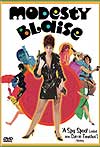 Joseph
Losey's light-hearted, James Bond spy comedy-spoof Modesty Blaise (1966), was based upon a British newspaper comic strip
series, with Italian star Monica Vitti (in her first English-language film)
in the title role opposite Dirk Bogarde as the villain Joseph
Losey's light-hearted, James Bond spy comedy-spoof Modesty Blaise (1966), was based upon a British newspaper comic strip
series, with Italian star Monica Vitti (in her first English-language film)
in the title role opposite Dirk Bogarde as the villain- Robert Vaughn was master spy Napoleon Solo (code-named
The Man From U.N.C.L.E., a government enforcement agency meaning the United
Network Command for Law and Enforcement) who frequently battled the evil
T.H.R.U.S.H. (Technological Hierarchy for the Repression of Undesirables
and the Subjugation of Humanity), in To Trap A Spy (1966), the original
pilot for the popular TV series in the 60s released as a theatrical film;
Vaughn was partnered with David McCallum as blonde-haired Russian secret
agent Illya Kuryakin
- James Coburn starred as Derek Flint, a playboy hero in
the spy films: Our Man Flint (1966), and In Like Flint (1967);
Flint was an agent of Z.O.W.I.E. (Zonal Organization World Intelligence
Espionage); Ray Danton also played Flint in a 1976 TV pilot
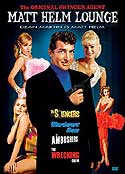 Columbia
contract star Dean Martin portrayed Matt Helm (based on the spy in Donald
Hamilton's novels) in four tongue-in-cheek films between 1966 and 1968: The Silencers (1966), Murderer's Row (1966), The Ambushers
(1967), and The Wrecking Crew (1968); none of the films' titles
had anything to do with their plots; Helm was a cheesecake model photographer-turned-American
agent for ICE (Organization for Intelligence and Counter-Espionage) Columbia
contract star Dean Martin portrayed Matt Helm (based on the spy in Donald
Hamilton's novels) in four tongue-in-cheek films between 1966 and 1968: The Silencers (1966), Murderer's Row (1966), The Ambushers
(1967), and The Wrecking Crew (1968); none of the films' titles
had anything to do with their plots; Helm was a cheesecake model photographer-turned-American
agent for ICE (Organization for Intelligence and Counter-Espionage)- Richard Johnson was featured in the resurrected role of
British agent Bulldog Drummond (a suave, gentleman-spy hero in many films
mostly made between the silents through to the late 40s) in Deadlier
Than the Male (1967) and Some Girls Do (1969)
- Neil Connery (Sean Connery's/James Bond's brother) appeared
in an action-spy film titled Operation Kid Brother (1967) (aka O.K.
Connery), also featuring perennial Bond characters Bernard Lee and Lois
Maxwell (although not identified as M or Miss Moneypenny)
- Frankie Avalon (and B-movie hunk George Nader) starred
as US espionage agents teamed with British intelligence to combat Goldfinger's
Shirley Eaton as the beautiful but deadly Su-Muru (a character based on
a series of Sax Rohmer novels) intent on world domination with a vast band
of man-hating women, in The Million Eyes of Sumuru (1967) (aka The
1000 Eyes of Su-Muru)
- David Niven headlined Casino Royale (1967) - a direct
spoof of the James Bond character
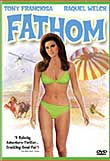 sexy
Raquel Welch sizzled as Fathom Harvill, a champion sky diver recruited by
a Western spy organization for a top secret mission in Fathom (1967),
co-starring Tony Franciosa as millionaire Peter Merriwether, who was believed
to possess an H-bomb detonator known as the Fire Dragon sexy
Raquel Welch sizzled as Fathom Harvill, a champion sky diver recruited by
a Western spy organization for a top secret mission in Fathom (1967),
co-starring Tony Franciosa as millionaire Peter Merriwether, who was believed
to possess an H-bomb detonator known as the Fire Dragon- When Eight Bells Toll (1971) was adapted from Alistair MacLean's bestselling book, and set in the Scottish
Highlands, with Anthony Hopkins in a Bond-like role as Philip Calvert in
a search for missing/stolen government gold bullion
- The Tall Blonde Man with One Red Shoe (1972, Fr.) was a wacky French spy comedy with Pierre Richard, followed by a sequel
two years later: The Return of the Tall Blonde Man with One Black Shoe
(1974)
- Le Magnifique (1973, Fr.) (aka How to Destroy
the Reputation of the Greatest Secret Agent in the World), was a spy-comedy
parody of the James Bond films, starring Jean Paul Belmondo
- John Landis' 'Road' spy comedy Spies Like Us (1985) featured Chevy Chase and Dan Aykroyd as two aspiring but misfit CIA agents
- the spy-comedy spoof, Leonard,
Part 6 (1987), a big flop, starred Bill Cosby as ex-agent Leonard Parker
engaged in a mission to stop the evil Medusa (Gloria Foster)
- If Looks Could Kill (1991) - the feature film debut of Richard Grieco, a teen-oriented spoof of the James Bond films
- The Double O Kid (1992) was
another juvenile-oriented spoof/parody about a youthful rookie spy (Corey
Haim)
- Spy Hard (1996), a low-brow
spy comedy, with Leslie Nielsen as Dick Steele (Agent WD-40), with aid from
Russian agent Veronique Ukrinsky (Nicolette Sheridan), against armless mad-man
villain Andy Griffith - who has plans to conquer the world
- Mike Myers appeared as the International Man of Mystery
in the satirizing spy spoofs Austin Powers: International Man of Mystery
(1997), Austin Powers: The Spy Who Shagged Me (1999), and Austin
Powers in Goldmember (2002), all by director Jay Roach
- Johnny English (2003), a comedy
of errors spy film with Rowan Atkinson (known for roles as Mr. Bean) as
the bumbling superspy title character, another funny parody of the James
Bond films
- Malcolm in the Middle star Frankie Muniz was teenaged
CIA super-agent Banks in Agent Cody Banks (2003), and in the sequel Agent Cody Banks 2: Destination London (2004)
Spy and Thriller Films After James Bond:
 On
the flip side of the James Bond series were other tense, Cold War
political tales of espionage and intrigue including the ultimate
political thriller about brainwashing and political assassination
- The
Manchurian Candidate (1962), Fail Safe (1964) about
a doomsday scenario (released less than a year after Kubrick's black
comedy with the same plot - Dr.
Strangelove, Or: (1964)), Edward Dmytryk's Mirage (1966) with
Gregory Peck and Diane Baker, and Seven Days in May (1964). On
the flip side of the James Bond series were other tense, Cold War
political tales of espionage and intrigue including the ultimate
political thriller about brainwashing and political assassination
- The
Manchurian Candidate (1962), Fail Safe (1964) about
a doomsday scenario (released less than a year after Kubrick's black
comedy with the same plot - Dr.
Strangelove, Or: (1964)), Edward Dmytryk's Mirage (1966) with
Gregory Peck and Diane Baker, and Seven Days in May (1964).
More modern, complex, high-intensity political thrillers
with paranoic political atmosphere, double- and triple-crosses,
threats to entire countries, spies, assassins, conspiracies, and
electronic surveillance include:
- the 'Harry Palmer' spy mystery trilogy featured a reluctant,
bespectacled, unglamorous British secret serviceman (Michael Caine) (from
the best-selling novel by Len Deighton) in The Ipcress File (1965), Funeral in Berlin (1967) and Billion Dollar Brain (1967);
also two other obscure follow-up action/spy thriller films with Michael
Caine reprising his role were: Bullet to Beijing (1995) and Midnight
in St. Petersburg (1997)
- Richard Burton was British undercover agent Alec Leamas
(code-named Expendable) behind the Iron Curtain in Martin Ritt's unglamorized
and bleak The Spy Who Came in From the Cold (1965), adapted from
John Le Carre's novel; the spy character George Smiley was played by Rupert
Davies in the film (and made famous by Alec Guinness on TV)
- an American version of 'Harry Palmer' with a Harold Pinter
screenplay from the first of Adam Hall's many Quiller novels - was
Quller, an agent (George Segal) called upon by Alec Guinness to infiltrate
the neo-Nazis (led by Max von Sydow) in post-war Berlin, in The Quiller
Memorandum (1966)
- Sidney Lumet's The Deadly Affair (1967), based John
LeCarre's Call for the Dead with James Mason as a British secret
agent
- Terence Young's The Triple Cross (1967), based on
a true story, starred Christopher Plummer as Eddie Chapman, a safe-cracker
who joined with the Germans during the war, and then became a British double-agent
- director Fred Zinnemann's political thriller The Day
of the Jackal (1973) was about an attempt on the life of French President
Charles DeGaulle
- Don Siegel's The Black Windmill (1974), derived
from the Clive Egleton novel Seven Days to a Killing, with Michael
Caine as MI-5 operative John Tarrant, an espionage agent whose son has been
kidnapped
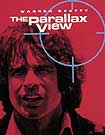 Francis
Ford Coppola's The Conversation (1974), filmed
during the Watergate era, was about a wire-tap, sound surveillance expert
named Harry Caul (Gene Hackman) who discovered more than he bargained for Francis
Ford Coppola's The Conversation (1974), filmed
during the Watergate era, was about a wire-tap, sound surveillance expert
named Harry Caul (Gene Hackman) who discovered more than he bargained for- director Alan Pakula's The Parallax View (1974) told of a conspiracy, led by the Parallax Corporation, surrounding the assassination
of a US Senator running for President that was witnessed by investigative
reporter Joseph Frady (Warren Beatty)
- The Odessa File (1974) was loosely based upon the
Frederick Forsyth novel, a tense political thriller with Jon Voight as a
German reporter searching for missing Nazi war criminals in 1963 Hamburg,
Germany, and taking on the Israeli Secret Service (a group called Odessa),
and Maximilian Schell as the evil villain
- Sydney Pollack's box-office hit Three Days of
the Condor (1975) starred Robert Redford as a targeted US
CIA-intelligence researcher on the run from professional assassin
Max Von Sydow; based on James Grady's novel Six Days of the
Condor
- Peter Hyam's science-fiction thriller Capricorn
One (1977) proposed the government conspiracy-theory idea
that the first mission to Mars landing was a complete fake
- Sam Peckinpah's final film, the plot twisting spy film The Osterman Weekend (1983), was based on Robert Ludlum's best-selling
novel and starred John Hurt as creepy CIA agent-spy Lawrence Fassett
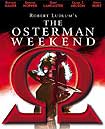 UK's
political conspiracy thriller Defence of the Realm (1985), featured
Gabriel Byrne as a reporter investigating a covert operation UK's
political conspiracy thriller Defence of the Realm (1985), featured
Gabriel Byrne as a reporter investigating a covert operation- John MacKenzie's action-spy thriller The Fourth Protocol
(1987), derived from a script by the original novelist Frederick Forsyth,
featured Michael Caine as British intelligence agent John Preston and Pierce
Brosnan as bad-guy Russian agent Maj. Valeri Petrofsky
- in the 1990s, Tom Clancy's techno-thriller novels provided
the plots for numerous films with an all-American hero and CIA agent Jack
Ryan: in The Hunt for Red October (1990) with Alec Baldwin, Patriot
Games (1992) and Clear and Present Danger (1994) with Harrison
Ford, and The Sum of All Fears (2002) with Ben Affleck
- Phil Alden Robinson's techno-action thriller Sneakers
(1992) told of a mission by leader Robert Redford (and a group of renegade
hackers) to obtain a code-breaking machine that could penetrate any computer
system on Earth, with the ponytailed mastermind villain played by Ben Kingsley
- James Cameron's recent action-filled True Lies (1994) starred Arnold Schwarzenegger as Omega Sector secret agent Harry Tasker
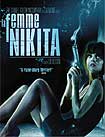 Brian
De Palma's glossy and complex blockbuster Mission: Impossible (1996) (and the other sequels) featured high-powered star Tom Cruise, clever gadgets, exotic locales, great
action sequences, double-crosses, etc., and was based upon the 60's TV show
of the same name (also noted for techno-gadgetry, face-mask impersonations,
and fast action) Brian
De Palma's glossy and complex blockbuster Mission: Impossible (1996) (and the other sequels) featured high-powered star Tom Cruise, clever gadgets, exotic locales, great
action sequences, double-crosses, etc., and was based upon the 60's TV show
of the same name (also noted for techno-gadgetry, face-mask impersonations,
and fast action)- writer/director Luc Besson's action thriller La Femme
Nikita (1990) (aka Nikita), was a significant spy film about
a young female political assassin (played by Besson's wife Anne Parillaud);
it was remade in Hong Kong as Black Cat (1991) and in the US by director
John Badham as Point of No Return (1993) with Bridget Fonda
- Gillian Armstrong's Charlotte
Gray (2001), a wartime romance and spy film, based
on the best-selling novel by Sebastian Faulks, starring Cate Blanchett as
the title character, a Scottish woman serving as a spy for the French resistance
forces while being a nanny and searching for her lover - a downed RAF pilot
- Michael Apted's WWII spy film Enigma (2001), had
some authentic depictions of code-breaking and intelligence technology developed
during WWII to decode secret German messages
- John Boorman's The Tailor of Panama (2001) based
on John Le Carre's 1996 novel by the same name, starred Bond actor Pierce
Brosnan as non-Bondish British spy Andrew Osnard, and was set in the Panama
Canal area in late 1999
- Robert Rodriguez' stunt-filled Spy Kids (2001),
starred young agents Alexa Vega (as Carmen) and Daryl Sabara (as Juni),
children of a pair of secret agents, who must save their parents; sequels
included Spy Kids 2: The Island of Lost Dreams (2002), and Spy
Kids 3-D: Game Over (2003)
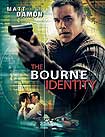 Rob
Cohen's spy-thriller XXX (2002) tried to re-make James Bond for the
next generation of viewers in the persona of Vin Diesel as Xander Cage,
a nihilist extreme sports enthusiast nicknamed "Triple X", who
was recruited by a covert government agency to infiltrate a Russian crime
ring called Anarchy 99 Rob
Cohen's spy-thriller XXX (2002) tried to re-make James Bond for the
next generation of viewers in the persona of Vin Diesel as Xander Cage,
a nihilist extreme sports enthusiast nicknamed "Triple X", who
was recruited by a covert government agency to infiltrate a Russian crime
ring called Anarchy 99- director Doug Liman's The Bourne Identity (2002),
from Robert Ludlum's best-selling novel was about code-named Jason Bourne
(portrayed by Matt Damon) as an amnesiac agent with martial-arts skills;
Richard Chamberlain starred as Bourne, opposite Jaclyn Smith, in the 1988
TV-movie/mini-series version of the same novel; also the sequels The
Bourne Supremacy (2004) and The Bourne Ultimatum (2006)
- Roger Donaldson's The Recruit (2003), with Colin
Farrell as a recent MIT graduate recruited by Al Pacino to be trained as
a CIA agent
- director/screenwriter Stephen Gaghan's political thriller Syriana (2005) was based upon Robert Baer's real-life experiences
as an American intelligence agent in the Middle East, written up in his
book See No Evil: The True Story of a Ground Soldier in the CIA's War
on Terrorism; starred George Clooney as Baer and Matt Damon as an oil
executive
- director/star Robert DeNiro's The Good Shepherd (2005) was a film about the CIA's inner workings
|
